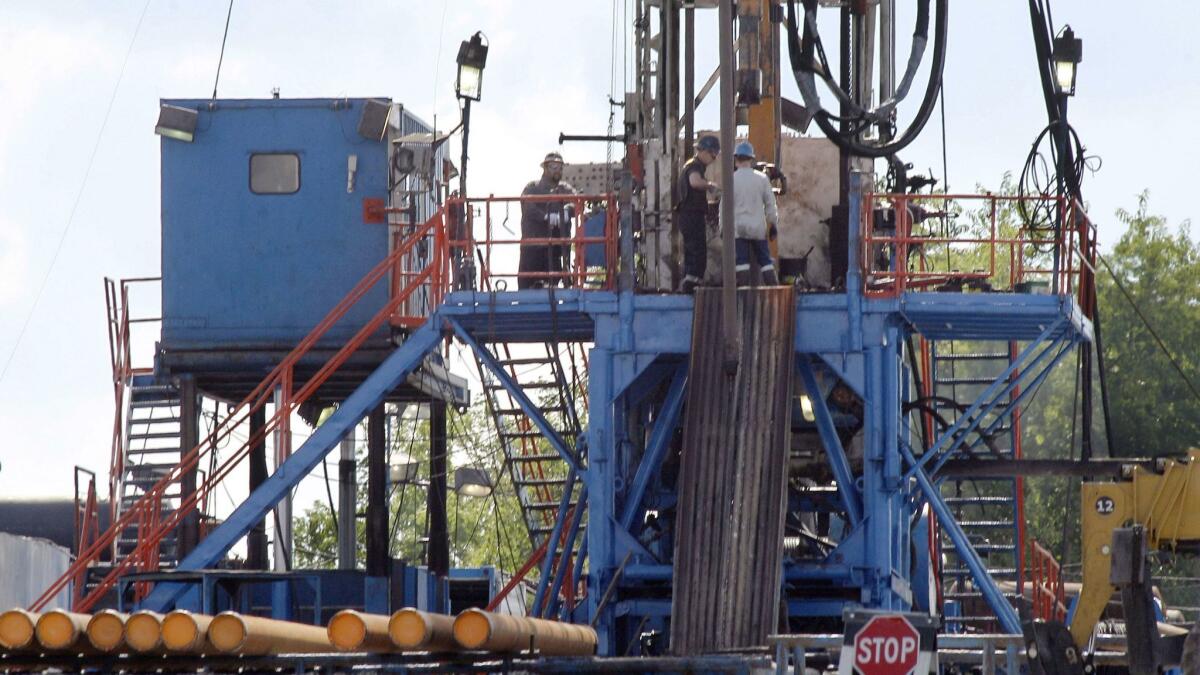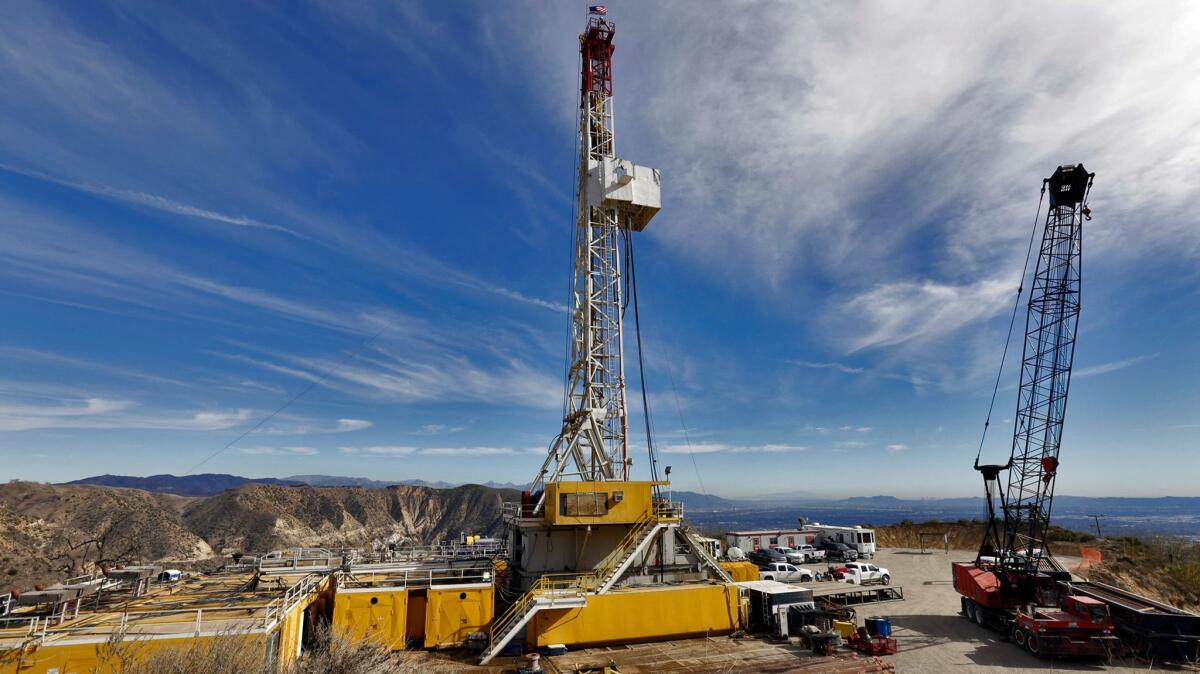Natural gas is energy’s new king — but how long will it reign? California may offer some clues

- Share via
Natural gas has overtaken coal as the nation’s No. 1 source of electricity and the gap appears to be getting wider each year.
- Even in California, natural gas is at the top. Why has it grown so quickly? Hydraulic fracturing (fracking) and horizontal drilling techniques have made natural gas abundant, which has driven down its price.
- The costs of renewable energy sources like wind and solar are dropping too and in an ironic twist, adding renewables to the grid often requires natural gas to “fill in the gaps.”
- But natural gas faces headwinds — from environmental groups and a growing school of thought there’s a glut of natural gas in California’s power system.
- A number of energy companies like San Diego’s Sempra see shipments around the world of liquefied natural gas (LNG) as a big money-maker.
The rise of natural gas and its cloudy future: Here’s the full story
King Coal has been kicked off the throne.
Natural gas is now the nation’s leading source of electricity. It is abundant and cheap, which has not only crippled the coal industry but has also impacted virtually every other source of power that makes up the energy grid.
Some have estimated there is enough natural gas in the U.S. to meet the country’s energy needs for about 200 years.
But “King Gas” has its critics — especially among environmentalists — and California’s fast-changing energy landscape offers hints that a long, smooth reign for natural gas is far from assured.
The nat gas revolution
As late as 1986, natural gas made up just 10 percent share of the country’s power. By 2016, that figure leaped to 34 percent, supplanting coal as the No. 1 source of electricity. The U.S. Energy Information Administration last week projected the nation’s use of electricity from gas will exceed coal by 6 percent by next year.
What changed?
The combination of hydraulic fracturing (fracking) and horizontal drilling techniques in shale formations such as the Barnett in Texas and the Marcellus Shale in Pennsylvania and parts of Ohio and West Virginia allowed producers to unlock vast amounts of natural gas.
Just a few years ago, the U.S. had to import natural gas from other countries to meet its needs. Today, there is so much the equation has been turned around: American producers now export natural gas to places like Mexico.
Burgeoning supplies caused the price of natural gas to drop. At some periods between 2003 and 2008, the price approached $14 per million BTUs. Since the fracking boom, prices averaged less than $3.20 between 2012 and 2016.
Despite the recent deep freeze in large parts of the country, the price on the natural gas futures market remained below $3 per million BTUs.
Low prices, combined with the flexibility afforded by natural gas — combined-cycle gas plants have the ability to “ramp up” power very quickly — makes it very attractive to utilities.
In addition, natural gas burns twice as cleanly as coal.
“The biggest, most disruptive innovation in the energy sector in the last 30 years is unconventional natural gas,” said Frank Wolak, professor of economics and an energy expert at Stanford University. “There is no doubt that if that innovation had not occurred, we would be burning even more coal and coal would probably be an even greater share of the U.S. electricity mix than it was even in, say, 2000, before the shale gas boom.”
A ripple effect on other energy sources
Even major oil companies are focusing more on natural gas. For example, of the 16 new projects BP plans to complete by 2021, 12 of them involve natural gas instead of oil.
Diesel is also feeling the impact. An increasing number of city governments have transitioned their fleet of metropolitan vehicles, such as buses, from diesel to natural gas. In San Diego, diesel-powered garbage trucks are in the process of being replaced by trucks running on compressed natural gas.
Low natural gas prices have delivered a body blow to nuclear power, eating into their revenues. An analysis by Bloomberg New Energy Finance said more than half the reactors in the country are losing money.
The San Onofre Nuclear Generating Station shut down in January 2012 and the sole nuclear plant left in California, Diablo Canyon, is slated to begin to closing its doors in 2024.
It appears nuclear’s losses equals gains for natural gas.
When San Onofre closed, the percentage of natural gas as a percentage of California’s in-state generation ballooned from 45.4 percent in 2011 to 61.1 percent in 2012, according to figures from the California Energy Commission (CEC).
The renewables/nat gas rivalry
But the price of renewable energy sources such as solar and wind is falling, too.
And lower costs plus aggressive mandates from state policymakers have resulted in California becoming a leader in integrating renewables into the state’s power mix.
In the CEC’s most recent figures, the percentage of in-state generation from renewables reached 27.9 percent in 2016 — nearly twice as much generated in 2009.
No other single energy source in California other than renewables can rival natural gas.
But in a world where the push-pull between fossil fuels and renewables is often just as polarized as the current political climate, an irony has played out: Growth in wind and solar is often linked to, not separate from, growth in natural gas.
That’s because wind and solar have problems with intermittency — that is, solar production slips when the sun doesn’t shine and electricity generated by wind wanes when breezes don’t blow.
Supplies of natural gas smooth out the gaps.
Mark Zoback, director of the Natural Gas Initiative at Stanford University, said the relationship between renewables and natural gas is not an either/or proposition.
“They’re naturally complementary,” Zoback said. “When you have a lot of renewables, if the sun is really shining, which is mostly in the afternoon, or the wind is really blowing, which is mostly at night, you can cycle the natural gas plants to compensate for what the renewables are or are not doing.”
Zoback said the long-term future of energy will belong to renewable sources but they’re not there yet and abundant supplies of natural gas will help foster the transition.
The opposition
Environmental groups, which consider fracking anathema, are uniformly opposed to natural gas.
While cleaner than coal, natural gas is nonetheless a fossil fuel that emits greenhouse gases. Natural gas is mostly made up of methane and there are concerns about leaks because methane, if released into the atmosphere, is about 30 times more potent than CO2.
Many green green groups consider every new gas well as a roadblock in the path toward an energy future powered completely by renewables.
“Natural gas has always sounded clean because it has the word ‘natural’ in it,” said Dan Jacobson, state director at Environment California, “but when you take into account the environmental impacts and the dangers of climate change associated with natural gas it might be natural but it’s not good for the environment.”
And in California, there’s a growing school of thought there is too much natural gas in the system.
A Los Angeles Times investigation last year reported a growing glut of power in the state. California power plants, based on estimates, were on track to produce at least 21 percent more electricity than needed by 2020.
The $300 million Sutter Energy Center north of Sacramento closed in 2016 because the power it produced was no longer needed.
“We’ve been building up our gas-fire infrastructure at a rate that we could turn off every solar panel and every wind turbine right now and we wouldn’t skip a beat,” said Bill Powers, an engineer and consumer advocate based in San Diego. “We have built so much gas-fired capacity that we don’t need any of that to operate our grid reliably.”
Powers believes the $2.2 billion, 558-megawatt Carlsbad Energy Center, scheduled to be completed by the end of this year, is not needed. San Diego Gas & Electric officials have called it ”the new workhorse for the region” and say it will help California meet its target of 33 percent clean-energy generation by 2020 and 50 percent by 2030.

Others point to the fact the Aliso Canyon natural gas storage facility was offline for 17 months but Southern Californians did not experience serious power outages as evidence the facility is not critical to grid reliability.
Aliso Canyon is the site of the largest methane leak from a natural gas storage facility in U.S. history and forced the evacuation of more than 8,000 households in the Porter Ranch neighborhood of Los Angeles County.
Gary Ackerman, executive director of the Western Power Trading Forum, an organization based in Sacramento whose 90 members in the West buy and sell power, said concerns about an over-supply of natural gas can be misleading.
“One could point the finger at any supply source, such as solar (yes, we export solar-generated power outside of California), hydro, or even imported power from the Pacific Northwest into California,” Ackerman said in an email. “When it comes to building too much, then everything is too much, not just out-of-the-money gas-fired power plants.”
Gas critics point to flattening power demand in the state in recent years — due in part to greater energy efficiency measures, such as the use of LED lighting.
The development of energy storage systems powered by batteries may also pose a challenge to natural gas.
Right now, gas “peaker” plants are fired up to meet energy demands, such as when large numbers of utility customers fire up their air conditioners during heat waves.
But supporters of battery storage see a day when peaker plants will be replaced — by storing up energy when, say, wind and solar are producing at their maximum amounts and then deploying that energy when wind and solar production ebbs.
Storage systems are considered more expensive than natural gas but costs are falling and in an effort to grow the market, state policymakers in 2013 ordered the state’s three investor-owned utilities to buy a required amount of storage by 2020.
“California is a harbinger because we have the most aggressive targets for green power but the real story in the background is the price for solar continues to drop to levels that people just couldn’t believe we would reach at this point in time,” Powers said. “Battery storage is following the same trend.”
LNG on a roll
At the same time, a growing number of U.S. energy companies — including San Diego-based Sempra Energy — are placing big bets on a sector of the natural gas market with global reach.
Liquefied natural gas (LNG) results from gas being cooled to minus-260 degrees Fahrenheit and being condensed into liquid form so it can be transported. Until just a couple of years ago, LNG shipments chiefly came from countries such as Qatar and Australia.
But in 2016, Cheniere Energy became the first U.S. company to export LNG to foreign markets. It’s been a big success, with Cheniere reporting a tripling of revenue last year.
At least four other companies are right behind. Along with partners in Japan and France, Sempra is constructing a $10 billion LNG facility in Louisiana called Cameron. It’s expected to be finished in 2019.
Sempra is looking to build another LNG facility near Port Arthur, Texas and has also completed feasibility studies to add an export component to its LNG import terminal in Ensenada, Mexico.
In a call with financial analysts last April, Sempra president of infrastructure businesses Joe Householder projected distributions after debt service for Cameron of more than $11 billion during the project’s 20-year contract period.
“We’re going to get a mountain of cash, $11 billion in cash,” Householder said.
The U.S. Department of Energy projects LNG production capacity will quadruple by the end of next year and the International Energy Administration predicts the U.S. could become the world’s largest source of LNG within a decade.
LNG boosters say it can act as an economic cudgel over leaders such as Russia’s Vladimir Putin, whose state-run gas company Gazprom dominates energy markets in Europe.
Natural gas is so plentiful in the U.S., its backers say, that the market can absorb what will be shipped overseas without resulting in spikes in utility bills for domestic customers. Critics counter by saying natural gas has a history of price fluctuations and are not so sanguine that profits from LNG investments will be a slam dunk.
The future
Powers said natural gas dominance is no sure thing, pointing to falling prices for alternative energy sources.
“If in a few years you can produce power at $25 a megawatt hour from a solar field or buy it at a gas plant at $35, just on cost alone a lot of solar is going to be built, even in states where there’s no green mandate and no pressure to go green,” Powers said.
Zoback isn’t so sure.
“I’m 69 years old. I’m not going to be able to test these theories but my sense is that we’re going to see expanded use of natural gas for the next 20 years,” Zoback said. “In the following 20, it will have a useful decline and 40 to 50 years from now I think we will be using very little natural gas. We’ll largely have renewable sources.”
Business
(619) 293-1251 Twitter: @robnikolewski
More to Read
Inside the business of entertainment
The Wide Shot brings you news, analysis and insights on everything from streaming wars to production — and what it all means for the future.
You may occasionally receive promotional content from the Los Angeles Times.











